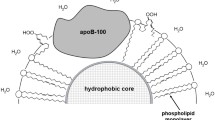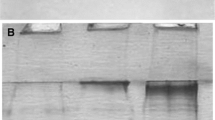Abstract
In this study, we show that low density lipoproteins (LDL) from human blood plasma which was oxidized by animal C-15 lipoxygenase is taken up by cultivated human macrophages with the same effectiveness as with non-oxidized (native) LDL. At the same time malonyldialdehyde-modified LDL is captured by cultivated macrophages very actively. Based on differences in catabolism of LDL with various levels of primary and secondary products of free-radical oxidation, it was offered to discriminate between the oxidized LDL itself (lipohydroperoxide-rich LDL) and the LDL that was chemically modified by free-radical oxidation secondary products of aldehyde nature. In this respect, aldehyde-modified but not oxidized (lipohydroperoxide-containing) LDL is atherogenic.


Similar content being viewed by others
Abbreviations
- LDL:
-
Low density lipoprotein
- LOX:
-
C-15 Lipoxygenase
- MDA:
-
Malonyldialdehyde
- PBS:
-
Phosphate-buffered saline
References
Steinberg D (2000) Is there a potential therapeutic role for vitamin E or other antioxidants in atherosclerosis? Curr Opin Lipidol 11(6):603–607
Lankin VZ, Tikhaze AK (2003) Atherosclerosis as a free radical pathology and antioxidative therapy of this disease. In: Tomasi A, Özben T, Skulachev VP (eds) Free radicals, nitric oxide, and inflammation: molecular, biochemical, and clinical aspects, vol 344. IOS Press, NATO Science Series, Amsterdam, pp 218–231
Lankin VZ, Tikhaze AK, Kapel’ko VI, Shepel’kova GS, Shumaev KB, Panasenko OM, Konovalova GG, Belenkov YuN (2007) Mechanisms of oxidative modification of low density lipoproteins under conditions of oxidative and carbonyl stress. Biochemistry (Mosc.) 72(10):1081–1090
Steinberg D, Witztum JL (2010) Oxidized low-density lipoprotein and atherosclerosis. Arterioscler Thromb Vasc Biol 30(12):2311–2316
Lankin VZ, Konovalova GG, Tikhaze AK, Nedosugova LV (2011) The influence of glucose on free radical peroxidation of low density lipoproteins in vitro and in vivo. Biochemistry (Mosc.) 5(3):284–292
Lankin VZ (2003) The enzymatic systems in the regulation of free radical lipid peroxidation. In: Tomasi A, Özben T, Skulachev VP (eds) Free radicals, nitric oxide, and inflammation: molecular, biochemical, and clinical aspects, vol 344. IOS Press, NATO Science Series, Amsterdam, pp 8–23
Hundal RS, Gómez-Muñoz A, Kong JY, Salh BS, Marotta A, Duronio V, Steinbrecher UP (2003) Oxidized low density lipoprotein inhibits macrophage apoptosis by blocking ceramide generation, thereby maintaining protein kinase B activation and Bcl-XL levels. J Biol Chem 278(27):24399–24408
Boullier A, Yankin L, Quehenberger O, Palinski W, Tabas I, Witztum JL, Miller YI (2006) Minimally oxidized LDL offsets the apoptotic effects of extensively oxidized LDL and free cholesterol in macrophages. Arterioscler Thromb Vasc Biol 26(5):1169–1176
Galle J, Schneider R, Heinloth A, Wanner C, Galle PR, Conzelmann E, Dimmeler S, Heermeier K (1999) Lp(a) and LDL induce apoptosis in human endothelial cells and in rabbit aorta: role of oxidative stress. Kidney Int 55(4):1450–1461
Takei A, Huang Y, Lopes-Virella MF (2001) Expression of adhesion molecules by human endothelial cells exposed to oxidized low density lipoprotein. Influences of degree of oxidation and location of oxidized LDL. Atherosclerosis 154(1):79–86
Colomé C, Martínez-González J, Vidal F, de Castellarnau C, Badimon L (2000) Small oxidative changes in atherogenic LDL concentrations irreversibly regulate adhesiveness of human endothelial cells: effect of the lazaroid U74500A. Atherosclerosis 149(2):295–302
Miller YI, Viriyakosol S, Binder CJ, Feramisco JR, Kirkland TN, Witztum JL (2003) Minimally modified LDL binds to CD14, induces macrophage spreading via TLR4/MD-2, and inhibits phagocytosis of apoptotic cells. J Biol Chem 278(3):1561–1568
Miller YI, Viriyakosol S, Worrall DS, Boullier A, Butler S, Witztum JL (2005) Toll-like receptor 4-dependent and-independent cytokine secretion induced by minimally oxidized low-density lipoprotein in macrophages. Arterioscler Thromb Vasc Biol 25(6):1213–1219
Itabe H, Mori M, Fujimoto Y, Higashi Y, Takano T (2003) Minimally modified LDL is an oxidized LDL enriched with oxidized phosphatidylcholines. J Biochem 134(3):459–465
Bae YS, Lee JH, Choi SH, Almazan F, Witztum JL, Miller YI (2009) Lipoprotein accumulation in macrophages via toll-like receptor-4-dependent fluid phase uptake. Circ Res 104(12):1355–1363
Esterbauer H, Striegl G, Puhl H, Rotheneder M (1989) Continuous monitoring of in vitro oxidation of human low density lipoprotein. Free Radic Res Commun 6(1):67–75
Yoshida Y, Furuta S, Niki E (1993) Effects of metal chelating agents on the oxidation of lipids induced by copper and iron. Biochim Biophys Acta 1210(1):81–88
Pinchuk I, Lichtenberg D (1999) Copper-induced LDL peroxidation: interrelated dependencies of the kinetics on the concentrations of copper, hydroperoxides and tocopherol. FEBS Lett 450(3):186–190
Horsley ET, Burkitt MJ, Jones CM, Patterson RA, Harris LK, Moss NJ, del Rio JD, Leake DS (2007) Mechanism of the antioxidant to pro-oxidant switch in the behavior of dehydroascorbate during LDL oxidation by copper(II) ions. Arch Biochem Biophys 465(2):303–314
Nenseter MS, Halvorsen B, Rosvold O, Rustan AC, Drevon CA (1995) Paracetamol inhibits copper ion-induced, azo compound-initiated, and mononuclear cell-mediated oxidative modification of LDL. Arterioscler Thromb Vasc Biol 15(9):1338–1344
Kontush A, Spranger T, Reich A, Djahansouzi S, Karten B, Braesen JH, Finckh B, Kohischutter A, Beisiegel U (1997) Whole plasma oxidation assay as a measure of lipoprotein oxidizability. Biofactors 6(2):99–109
Raveh O, Pinchuk I, Fainaru M, Lichtenberg D (2001) Kinetics of lipid peroxidation in mixtures of HDL and LDL, mutual effects. Free Radic Biol Med 31(11):1486–1497
Panasenko OM, Sergienko VI (2001) Hypochlorite, oxidative modification of plasma lipoproteins, and atherosclerosis. Bull Exp Biol Med 131(5):407–415
Panasenko OM, Vakhrusheva TV, Vlasova II, Chekanov AV, Baranov YV, Sergienko VI (2007) Role of myeloperoxidase-mediated modification of human blood lipoproteins in atherosclerosis development. Bull Exp Biol Med 144(3):428–431
Jayaraman S, Gantz DL, Gursky O (2007) Effects of oxidation on the structure and stability of human low-density lipoprotein. Biochemistry 46(19):5790–5797
Agil A, Fuller CJ, Jialal I (1995) Susceptibility of plasma to ferrous iron/hydrogen peroxide-mediated oxidation: demonstration of a possible Fenton reaction. Clin Chem 41(2):220–225
Klouche K, Morena M, Canaud B, Descomps B, Beraud JJ, Cristol JP (2004) Mechanism of in vitro heme-induced LDL oxidation: effects of antioxidants. Eur J Clin Ivest 34(9):619–625
Miller YI, Altamentova SM, Shaklai N (1997) Oxidation of low-density lipoprotein by hemoglobin stems from a heme-initiated globin radical: antioxidant role of haptoglobin. Biochemistry 36(40):12189–12198
Bamm VV, Tsemakhovich VA, Shaklai N (2003) Oxidation of low-density lipoprotein by hemoglobin-hemichrome. Int J Biochem Cell Biol 35(3):349–358
Natella F, Nardini M, Ursini F, Scaccini C (1998) Oxidative modification of human low-density lipoprotein by horseradish peroxidase in the absence of hydrogen peroxide. Free Radic Res 29(5):427–434
Aviram M, Kent UM, Hollenberg PF (1999) Microsomal cytochromes P450 catalyze the oxidation of low density lipoprotein. Atherosclerosis 143(2):253–260
Hulten LM, Ullström C, Krettek A, van Reyk D, Marklund SL, Dahlgren C, Wiklund O (2005) Human macrophages limit oxidation products in low density lipoprotein. Lipids in Health and Disease 4:6–17
Bilenko MV, Khil’chenko AV, Konovalova GG, Lankin VZ (2003) Effect of antioxidant probucol on cell-mediated LDL oxidation in vitro and in vivo. Bull Exp Biol Med 136(2):126–128
Zhao R, Shen GX (2005) Functional modulation of antioxidant enzymes in vascular endothelial cells by glycated LDL. Atherosclerosis 179(2):277–284
Deev AI, Osis YuG, Formaziuk VE, Vladimirov YuA, Lankin VZ (1983) Increase of the water content in the lipid phase of lipoproteins during peroxidation. Biophysics 28(4):629–631 [Article in Russian]
Formaziuk VE, Osis YuG, Deev AI, Lankin VZ, Vladimirov YuA (1983) Effect of lipid peroxidation on the structure of serum lipoproteins. Biochemistry (Mosc.) 48(2):331–338
Lankin VZ, Osis YuG, Tikhaze AK (1996) Hydroperoxy- and hydroxy-derivatives of free unsaturated fatty acids and phospholipids as modifiers of liposomal membrane structure. Doklady Biochemistry 351(2):269–271
Lankin VZ, Tikhaze AK, Osis YuG (2002) Modeling the cascade of enzymatic reactions in liposomes including successive free radical peroxidation, reduction, and hydrolysis of phospholipid polyenoic acyls for studying the effect of these processes on the structural-dynamic parameters of the membranes. Biochemistry (Mosc.) 67(5):566–574
Osis YuG, Lankin VZ, Vikhert AM (1984) Animal lipoxygenases as an instrument for the peroxidation of membrane phospholipids. Doklady Biochemistry 276(4):989–992
Lankin VZ, Gordeeva NT, Osis YuG, Vikhert AM, Schewe T, Rapoport SM (1983) Animal lipoxygenases: changes in lipoxygenase activity from reticulocytes during interaction with blood plasma lipoproteins. Biochemistry (Mosc.) 48(6):914–921
Lankin VZ, Gordeeva NT, Tikhaze AK, Vikhert AM (1985) Animal lipoxygenases: the nature of substrates and changes in conformation of reticulocyte lipoxygenase in its interaction with membranes. Biochemistry (Mosc.) 50(11):1894–1900
Lankin VZ, Kühn H, Hiebsch C, Schewe T, Rapoport S, Tikhaze AK, Gordeeva NT (1985) On the nature of the stimulation of the lipoxygenase from rabbit reticulocytes by biological membranes. Biomed. Biocim. Acta. 44(5):655–664
Nekrasov AS, Lankin VZ, Vikhert AM (1986) Cholesterol esters as a substrate of animal lipoxygenases. Doklady Biochemistry 290(3):755–758
Belkner J, Wiesner R, Kühn H, Lankin VZ (1991) The oxygenation of cholesterol esters by the reticulocyte lipoxygenase. FEBS Lett 279(1):110–114
Kühn H, Wiesner R, Stender H, Schewe T, Lankin VZ, Nekrasov AS, Rapoport SM (1986) Requirement of monohydroperoxy fatty acids for the oxygenation of 15LS-HETE by reticulocyte lipoxygenase. FEBS Lett 203(2):247–252
Belkner J, Stender H, Kühn H (1997) 15-Lipoxygenase preferentially oxygenates a subfraction of human low density lipoprotein. Adv Exp Med Biol 407:465–469
Tertov VV, Kaplun VV, Dvoryantsev SN, Orekhov AN (1995) Apolipoprotein B-bound lipids as a marker for evaluation of low density lipoprotein oxidation in vivo. Biochem Biophys Res Commun 214(2):608–613
Requena JR, Fu MX, Ahmed MU, Jenkins AJ, Lyons TJ, Baynes JW, Thorpe SR (1997) Quantification of malondialdehyde and 4-hydroxynonenal adducts to lysine residues in native and oxidized human low-density lipoprotein. Biochem J 322(Pt 1):317–325
Fogelman AM, Shechter I, Seager J, Hokom M, Child JS, Edwards PA (1980) Malondialdehyde alteration of low density lipoproteins leads to cholesteryl ester accumulation in human monocyte-macrophages. Proc Natl Acad Sci USA 77(4):2214–2218
Yagi K (1984) Assay for blood plasma or serum. Methods Enzymol 105:328–333
Tertov VV, Sobenin IA, Gabbasov ZA, Popov EG, Jaakkola O, Solakivi T, Nikkari T, Smirnov VN, Orekhov AN (1992) Multiple-modified desialylated low density lipoproteins that cause intracellular lipid accumulation. Isolation, fractionation and characterization. Lab Invest 67(5):665–675
Hara A, Radin NS (1978) Lipid extraction of tissues with a low-toxicity solvent. Anal Biochem 90(1):420–426
Lankin VZ, Tikhaze AK, Belenkov YuN (2004) Antioxidants in complex therapy of atherosclerosis: pro et contra. Cardiology 44(2):72–81 [Review in Russian]
Author information
Authors and Affiliations
Corresponding author
Rights and permissions
About this article
Cite this article
Lankin, V.Z., Tikhaze, A.K. & Kumskova, E.M. Macrophages actively accumulate malonyldialdehyde-modified but not enzymatically oxidized low density lipoprotein. Mol Cell Biochem 365, 93–98 (2012). https://doi.org/10.1007/s11010-012-1247-5
Received:
Accepted:
Published:
Issue Date:
DOI: https://doi.org/10.1007/s11010-012-1247-5




